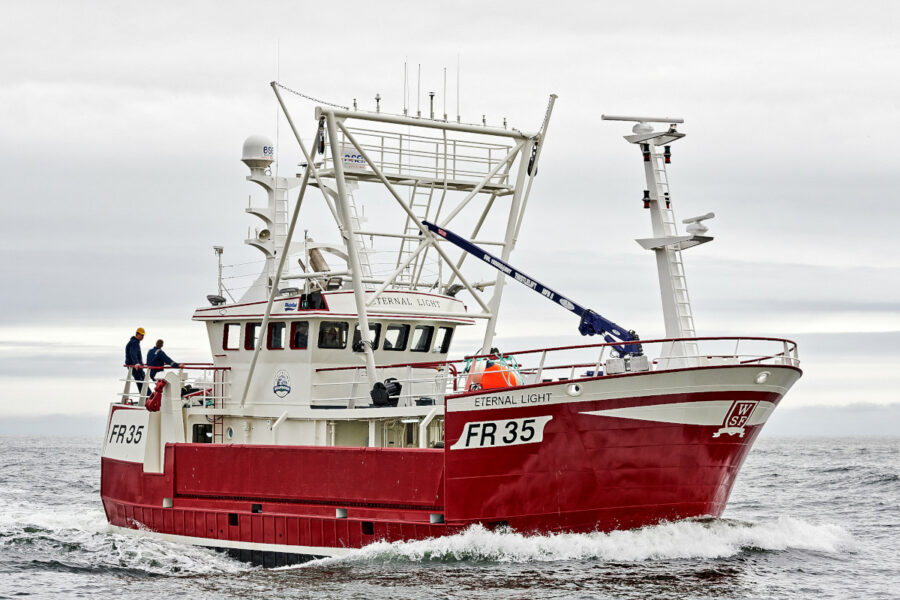Handed over to Whitelink Seafoods by Macduff Shipyards last month, the 19.2m automated scalloper Eternal Light FR 35 represents a significant milestone for the Fraserburgh processor by being its first new build, reports David Linkie
King scallops caught by skipper Ian Taylor and the crew of Eternal Light are now being processed in Whitelink Seafoods’ modern factory at Fraserburgh, before being delivered to longstanding customers throughout Europe.
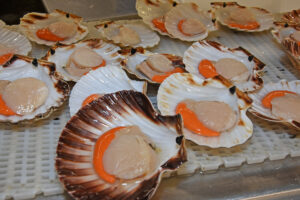
Prime-quality scallops being prepared for export in Whitelink Seafoods’ processing factory in Fraserburgh.
Whitelink Seafoods took delivery of Eternal Light 45 years after the third-generation family-owned company was established, underlining the continual programme of investment and gradual expansion that has been a hallmark of the company since 1974.
Eternal Light joins another three scallopers, Georgia Dawn, Eternal Promise and Eternal Friend, which Whitelink Seafoods purchased between 2015 and 2017.
In addition to underpinning catch continuity – an important factor in growing market sales – the rationale behind the decision to build Eternal Light was to maximise fishing efficiency, crew safety, fuel economy and catch quality.
When the decision to build a new scalloper was taken, Ian Taylor and George Jack put their extensive experience of skippering Georgia Dawn – which Macduff Shipyards completed in 2005 – to good use when liaising closely with Macduff Shipyards.
Design of Eternal Light began in the summer of 2017, when the overall aim was to develop a good platform from which to work 10 dredges per side, while keeping the registered length under 16.45m.
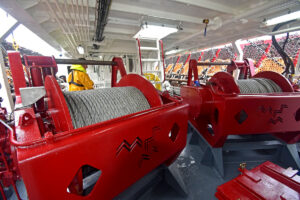
The main 20t split trawl winches are mounted forward on the main deck.
Particular focus was given to producing a hull design that would be economical to operate in years to come, to the need for a spacious working deck promoting efficient gear-handling arrangements, and to incorporating an automated catch-handling system, including outer hull tipping doors and catch hoppers/conveyors.
As is customary with all the yard’s new builds, the hull was developed in close co-operation with Macduff Ship Design, and CFD technology was used to optimise the hull form for fuel efficiency, including reducing areas of high resistance as much as practicable, and aligning external hull fittings with the water flow.
On completion of this stage, Macduff Ship Design created a full set of hull construction plans that were approved by SFIA, and produced the finished vessel’s stability booklet.
After the design was finalised, just over a year ago, Macduff Profilers started to cut the first steel for the hull units, which were fabricated between the Macduff and Buckie yards. The hull modules were assembled on the keel in Macduff Shipyards’ main fabrication hall in Buckie, where the vessel was fitted out to an advanced stage of completion, before going into the water towards the end of March.
Appropriately for a boat built at Buckie, Eternal Light is skippered by local man Ian Taylor, whose son, Rhys Taylor, sails as mate, having been at sea on Georgia Dawn since leaving school seven years ago.
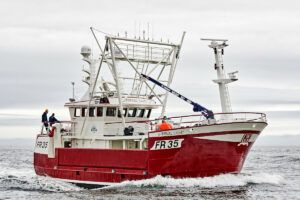
Eternal Light is Whitelink Seafoods’ first new boat.
After a short three-day shake-down trip on grounds in the Moray Firth north towards Orkney, Eternal Light immediately started to follow the pattern of semi-nomadic fishing that proved successful for skipper Ian Taylor on Georgia Dawn, by steaming over 700 miles to fish in the English Channel off Guernsey.
Oban Scallop Gear manufactured the complete set of 10-a-side scallop dredges now being used on Eternal Light, in conjunction with outer hull tipping doors and hydraulically operated pivoting towing arms.
Whitelink Seafoods’ director Andrew Sutherland said: “Building Eternal Light has been a completely new experience for us. From the outset, Macduff Shipyards ensured that it would be a smooth process by liaising closely with Ian Taylor, George Jack and ourselves every step of the way, as did the other major suppliers and service providers.
“That Eternal Light could be built in close proximity to Fraserburgh, which is the headquarters of Whitelink Seafoods, is extremely satisfying for everyone associated with the company. We are delighted with the end result, and wish skipper Ian Taylor and the crew safe and successful fishing in years to come.”
General layout
Insured by Sunderland Marine, Eternal Light has main dimensions of LOA 19.2m, registered length 16.45m, beam 7.2m, depth moulded 4.2m, draft 4.6m and GT 125t.
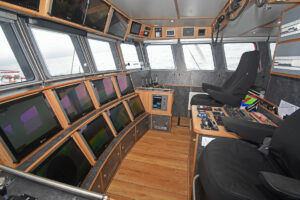
The wheelhouse is arranged to give easy access between the port and starboard fishing consoles.
Below main deck level, the layout of Eternal Light from forward follows the fairly standard arrangement of forepeak, including a large freshwater tank serving the ice machine and the access trunk for the Hardy bow thruster, fish hold, engineroom and accommodation.
Down the aft stair, the main accommodation cabin is arranged to give two four-berth cabins on either side of the compartment housing the Scan steering gear. Every opportunity has been taken to maximise locker storage and bench seating for the comfort of the crew.
At main deck level, a full-width casing is fitted across the transom. The galley/mess area lies parallel to the stern towards the starboard side, while a single-berth skipper’s cabin is orientated fore and aft along the port side.
Forward of this full-width arrangement is a central area where a shower/toilet compartment and dry locker area, together with exhaust trunking and escapes access, and the wheelhouse companionway, are located towards the aft end of the side reception hoppers and catch conveyors.
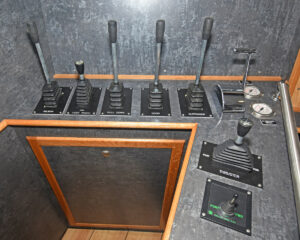
All items of deck machinery can be operated from wing consoles in the wheelhouse…
All internal accommodation areas on Eternal Light are completed to the extremely high quality of finish that Macduff Shipyards is renowned for.
Access from the deck house to the open working deck is through a well-equipped gear workshop, which performs a key role in enabling the crew to maintain the efficiency of Eternal Light’s scallop gear.
A key feature of Eternal Light is the amount of room, and the resulting freedom of movement, available on the main deck, on which only the main split trawl winches are positioned. The Gilson winches are located on the central steel shelterdeck, while the pulling-down winches are mounted on the legs of the lifting gantry amidships.
An enclosed catch-handling area, where crewmen pick scallops off the fore end of the side conveyors, is arranged between the working deck area and a weathertight whaleback. A Geneglace 1t flake ice machine, together with most of the plant for the fishroom refrigeration system, installed by Airo-Tech Solutions Ltd, is housed in this internal area, which is also racked out to provide secure storage for spare scallop gear and hardware.
Fishing arrangements

… and on the main deck.
The split trawl winches, outriggers, outer hull tipping doors and catch conveyors installed on Eternal Light were custom-designed, manufactured and commissioned in-house by Macduff Shipyards.
Port and starboard wing fishing consoles, which enable the skipper to have full control of the complete shooting and hauling sequence, are central to the full package.
All the deck machinery on Eternal Light is operated by two pumps driven from a JBJ splitter box, mounted on a Mitsubishi 6D24TCE variable-speed hydraulic engine developing 181kW @ 1,500rpm, mounted on the top of the port wing tank in the engineroom.
A clutched pump fitted to the gearbox PTO provides back-up hydraulic power.
Shooting and hauling duties are handled by two split trawl winches positioned forward on the main deck. Mounted on raised beds and hauling over the top of the large-diameter drums, the winches are angled slightly outwards to give straight leads over the top of the outer hull doors to large-diameter hanging blocks mounted on the outriggers.
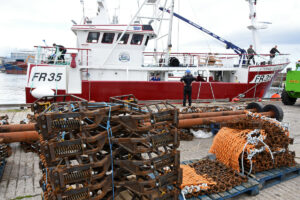
Oban Scallop Gear supplied a complete package of 10-a-side gear to Eternal Light.
Rated 20t core pull, the winches are fitted with Hagglunds compact two-speed drive motors for faster hauling and shooting of the wire. Two hundred and sixty fathoms of 26mm-diameter trawl wire, supplied by Karl Thomsen of Buckie, are accurately spooled on the drums at all times. A digital display console in the wheelhouse gives skipper Ian Taylor a continuous read out of the length of wire shot and shooting/hauling speeds.
Two 10t Gilson winches, supplied by Brevini, are mounted on the shelterdeck adjacent to the legs of the goalpost-style lifting gantry amidships. Two 3t pull-down winches are located on platforms welded to the tubular steel legs of the Gilson gantry, well above main deck level.
One-tonne tipping winches, which will be mainly used when changing over dredges at sea during a trip, are mounted on short derricks towards the top of the main lifting gantry.
The yard also fabricated the 10m outer hull tipping doors. Pivoted at the gunwale rail and extending for more than half the vessel’s length, the self-tipping doors are raised by two hydraulic rams mounted just inboard of the main deck scuppers. Considering that one set of scallop gear weighs nearly 2t, and that the contents of the dredges will often add a further 1t, the load lifted by these rams is considerable.

Bolting the tooth bars to the dredges ahead of fishing trials.
On hauling, the scallop bars are positioned along the top outer edge of the catch hoppers, with the full dredges hanging down outboard. Metal teeth on the outer face of the doors engage in the specially extended bellies of the scallop dredges, to hold them in position against the door as they are swung upwards through 170° to invert the dredges. Rocking the doors either side of vertical allows the contents of the dredges to fall into the wide rectangular-section hopper that extends the length of the scallop bars. After emptying, the raised side panels are lowered back into their recesses on the outside of the hull, allowing the gear to be shot away as usual.
A hydraulically operated slow-moving conveyor, fitted at the bottom of each side hopper, leads scallops and stones through openings in the otherwise fully enclosed forecastle bulkhead to the catch sorting areas forward. Standing in recessed deck wells, crewmen select scallops from the conveyor, before stones and other debris are returned to the sea through side chutes. Generous storage provision is made for filled baskets of scallops, before the contents are delivered via a central chute to a stainless steel reception hopper in the fishroom, for bagging in 38kg bags.
With a capacity for 750 bags of scallops, Eternal Light’s GRP-lined fishroom is equipped with a fan-based evaporator refrigeration system, installed by Fraserburgh company Airo-Tech Solutions Ltd.
Chilling comes from three large-capacity evaporator fans with automatic defrost, mounted in a single unit on the forward bulkhead of the fishroom. This delivers the benefit of constant and effective cooling of catches from top to bottom of each tier of bags, to ensure optimum levels of catch quality on landing.
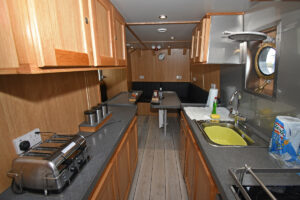
Two views of the galley…
Achieving consistent catch temperature in a conventional deckhead piped system is more difficult, as when the fishroom is full, there can be a considerable temperature difference between scallops near the top and those on the floor.
The cooling effect of pipework can also be jeopardised when the pipes ice up due to the moisture content in the fishroom, with the result that the system can be working at a very low capacity, and be unable to prevent temperatures rising.
The system on Eternal Light, which is similar to the one Ryan Summers installed on the Peterhead twin-rig trawler Westro earlier this year, eliminates this by automatically defrosting four times a day for around 30 minutes, to ensure maximum heat exchange across the system and constant effective cooling of catches.
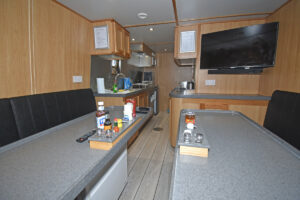
… and messdeck arranged across two-thirds of the transom.
Evaporator systems are also reported to be more energy-efficient than piped installations, as the greater cooling power means that the plant only needs to have been switched on for 30 minutes in order to reach the required temperature – normally 0°C to -1°C before hauling for the first time at the start of a trip – rather than when leaving harbour, possibly up to 12 hours earlier.
Ryan Summers also installed a Geneglace F30M flake ice machine, from which the daily output of 1t is expected to last longer, due to the capabilities of the vessel’s fishroom refrigeration system.
Bagged catches of king scallops are unloaded by a Thistlelift MFB8 stiff-boom landing crane. Manufactured by Thistle Marine of Peterhead, the crane is centrally positioned on the full-width forward section of the shelterdeck.
Mitsubishi main and auxiliary engines
The three Mitsubishi units fitted in Eternal Light’s engineroom were supplied and commissioned by Macduff Diesels.
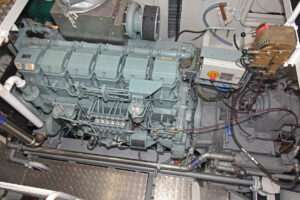
Macduff Diesels supplied the Mitsubishi main engine…
Dedicated to propulsion duties, the Mitsubishi S6R2-T2-MPTK-F main engine develops 480kW @ 1,350rpm and drives a 2,200mm-diameter four-bladed fixed-pitch Teignbridge propeller, turning in a new design of matching fixed nozzle, through a Masson Marine MM W6000 7.063:1 reduction gearbox.
This centreline drive arrangement delivers a maximum propeller speed of 190rpm, and one of around 115rpm when typically towing with the main engine running at 800rpm.
The remaining stern gear package was designed in-house by the shipyard and manufactured by Macduff Precision Engineering on CNC machines. Sea trials demonstrated encouraging results with the stern gear, which is fitted with Deep Sea Seals, delivering a very smooth and quiet performance in all operating modes, and strong towing performance.
A triple rudder arrangement, which Macduff Shipyards now designs and fabricates in-house, and fits to most new-builds with consistent success, is positioned behind the propulsion nozzle. Providing greater steering thrust, the triple rudder means that considerably smaller degrees of helm are needed for course alterations. This results in less power loss when turning, so helping to maintain a vessel’s speed and reduce fuel usage. Requiring very little helm to steer, the benefits of triple rudders are particularly noticeable when towing across the tide and following ground edges, as scallopers frequently do.
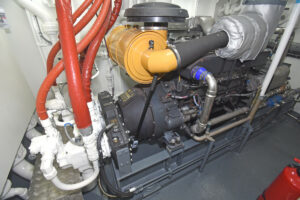
… the Mitsubishi 6D24TCE variable-speed hydraulic engine…
The centreline combination gave Eternal Light an average speed of 9.6 knots on sea trials. Perhaps more importantly for a vessel that will spend most of its time at sea towing, when comfortably towing 10-a-side dredges on fishing trials in the Moray Firth, Eternal Light was using some 40 litres of fuel an hour @ 780/800rpm. Skipper Ian Taylor was particularly impressed by Eternal Light’s initial towing capabilities, including coming round easily on the gear. The scalloper left Buckie to run off in a fresh northeasterly breeze that had generated some groundswell in the initially shallow water, which also gave an early opportunity for the anti-pitching fins fitted on the bulbous bow to show their value as Eternal Dawn steamed into weather, before conditions improved as the depth of water increased.
A Mitsubishi 6D24TCE variable-speed engine rated 182kW @1,500rpm drives Eternal Light’s main hydraulic system, in conjunction with a JBJ splitter box and two pumps. This auxiliary engine also runs a 48kW Mecc Alte 415/3/50 generator.
A second, similarly rated Mecc Alte electrical generator is run from a Mitsubishi S4KT auxiliary engine.
Eternal Light was wired through by RD Downie of Fraserburgh, which also manufactured the main engineroom and wheelhouse electrical distribution cabinet boards.
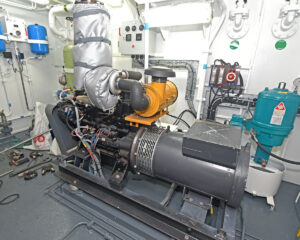
… and the Mitsubishi S4KT-based generator.
Cooling for the Mitsubishi main and auxiliary engines is provided through Blokland box coolers arranged across the forward end of the engineroom.
The engineroom on Eternal Light is particularly spacious, with an extremely well-thought-out arrangement ensuring maximum access for all levels of service in years to come.
A total of 20,000 litres of fuel is housed in a 1,200-litre daily service tank and two wing tanks in the engineroom. A double bottom tank under the fishroom floor holds 6,500 litres of freshwater, together with 4,000 litres in a forepeak tank.
Whitelink Seafoods
As the company’s first new build, Eternal Light represents a new venture for Fraserburgh processor Whitelink Seafoods Ltd.
The vessel is also a symbol of the forward-looking approach that has stood the family-owned company in good stead for 45 years. In this time, a continual programme of gradual growth, based on sustained reinvestment in the fishing industry, has seen Whitelink Seafoods develop into one of the leading processors in northeast Scotland, and also a major international company.
James and Marie Sutherland established Whitelink Seafoods in 1974, when they started to buy and pack winkles in the garage at the back of their house in Fraserburgh.
Today, the company is run by their sons Andrew, Graeme and James Sutherland, and their daughter Valerie Ritchie.
In addition to the Fraserburgh factory, where 180 staff are employed, Whitelink Seafoods has processing facilities at Newlyn, a production, sales and distribution factory in Boulogne, sales offices in Germany and Spain, and a processing factory in Iceland.
The first step along the development road was taken in 1978, when James and Marie moved their winkle operation to the North Breakwater (Steamboat Quay) in Fraserburgh harbour, where the bigger premises enabled them to start handling lobsters, and filleting initially small amounts of whitefish for the UK market.
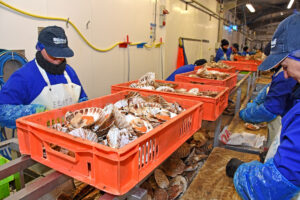
Processing the first scallops caught by Eternal Light…
The next step, and possibly one of the most significant, came in 1984, when an opportunity arose to start exporting fish to Europe.
In 1993, Whitelink moved to its existing premises in Fraserburgh which, 25 years later, continues to be developed in line with growth in production and market demand for prime-quality Scottish seafood.
Monkfish, catfish, ling, coley, tusk, pollack, cod, megrim, witches, squid, hake, turbot, prawns and scallops are the main species processed daily by highly skilled workers in Whitelink Seafoods’ Fraserburgh factory.
In addition to Fraserburgh and Peterhead markets, fish is sourced each morning from Shetland, where Andrew Hunter has represented Whitelink for 30 years, as well as other locations in Scotland, including Scrabster and Kinlochbervie, along with direct landings.
Some 90% of the company’s production, all processed to customers’ requirements, is destined for Europe, so understandably the family directors are keeping an ever-watchful eye on the increasingly drawn-out Brexit situation.
In order to ensure the company’s well-established levels of quality and freshness, maintaining existing access routes and a highly advanced transport logistics operation are viewed as being of paramount importance. Speed of delivery is particularly important for species like freshly caught squid from the Moray Firth, which Whitelink handles a lot of during the mainly summer fishery.
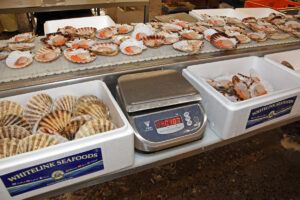
… in line with…
Exports are initially delivered to Whitelink Seafoods’ centre in Boulogne, for onward redistribution throughout Europe.
Already processing large quantities of king scallops, Whitelink Seafoods took the decision to underpin consistent catch supplies by buying its first boat, the 18m scalloper Georgia Dawn INS 140, from skipper George Jack in 2015, 10 years after the vessel was built by Macduff Shipyards.
The Eurocutter Sylvia T BM 112 followed the year after, when the 24m vessel, built by Maaskant Shipyards in 1992 as Wikingbank SC-20 and first brought to Brixham as Becky Lou, was renamed Eternal Promise.
Eternal Friend was bought by Whitelink Seafoods in 2017 in the form of the Eurocutter Saturnus KY 43, built at Den Helder by Visser in 1999.
King scallops from these three boats, and the new Eternal Light, are processed by Whitelink Seafoods at Fraserburgh to give a wide variety of products for niche market customers.
New wheelhouse equipment
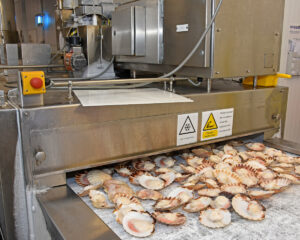
… customers’ requirements…
The advanced array of electronic equipment, including some new products, installed in Eternal Light’s wheelhouse, came from three Fraserburgh companies: Furuno UK, Seafield Navigation and Woodsons.
The importance of scallop skippers being able to visualise both the composition and the shape of the seabed is reflected by the state-of-the-art underwater acoustic sounding equipment and seabed plotting systems installed on Eternal Light.
This includes the first installation of Furuno’s new CH-500 searchlight sonar. Featuring the latest signal processing, sensing and other technologies, the new unit, which provides longer detection range, faster training speed, sharp echo image and built-in stabiliser, is a successor model to the highly popular and successful CH-250 sonar.
Seafield Navigation supplied a FishingWin (formerly Sodena) plotting system with pre-mapped 3D high-resolution seabed charts from Shetland south to the French coast. Incorporating more than a billion soundings and representing a five-year initiative by Seafield Navigation, pre-mapped charts enable skippers to fully visualise new grounds from the first tow, without the need for a vessel to build up historic evidence.
The 3D display gives ground contours, which can be overlaid with hard/soft ground discrimination data provided by Rozanne through a Koden CVS-1410HS echosounder. The FishingWin system also gives the facility to track the ends of the scallop beams.
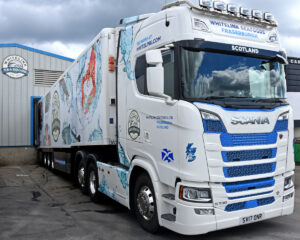
… for delivery to France in one of Whitelink Seafoods’ refrigerated vehicles.
Skipper Ian Taylor chose the FishingWin 3D system having been highly impressed by the benefits it yielded when installed on Georgia Dawn, when it enabled him to work new grounds and customise tows in relation to ground edges, gullies and peaks.
The internal layout of Eternal Light’s wheelhouse was designed to ensure easy access from the fishing consoles located at the forward corners of the wheelhouse, from which the full shooting/hauling sequence of the gear can be controlled, adjacent to duplicate sets of engine/steering controls mounted on slim consoles.
Most of the AG-Neovo monitors are flush-mounted in the two-tier main forward console. Two NorSap skipper’s seats are positioned either side of a central unit, flanked by two island consoles on which the master fishing console, engine/steering, autopilot and sonar control units are mounted.
An office area, in which two 17in monitors dedicated to vessel administration and the internet, is located in the aft starboard corner of the wheelhouse. Tea/coffee-making facilities, together with a compact sink and fridge, are located to port. The engine exhaust systems are routed up through a central housing, ensuring that the skipper has a clear line of sight to the towing arms at all times.
Eternal Light’s main vertical sounder is a Simrad ES80, complete with a 38kHz split-beam transducer.
The forward vision provided by the Furuno CSH 500 searchlight sonar is complemented by a WASSP F3 160kHz multibeam sonar system. This unit is interfaced to a Furuno TimeZero Professional V3.1 plotting system. As an integral part of the package that Furuno UK supplied, the TimeZero unit is interfaced with the vessel’s two FAR-1513 BB radars to display AIS and ARPA information.
A combination of AG Neovo X24 and X19 screen displays are fully switchable via an 8 x 8 HDMI unit.
Communication equipment includes a Sailor 6310 MF/HF GMDSS 150W radio telephone, two Sailor 6210 VHFs, Icom M 330 DSC VHF, Entel GMDSS handheld VHF, and an e-SEA 60kA satellite communications system.
Six external and four internal cameras, supplied and installed by Woodsons, together with a hull-mounted camera monitoring the propeller, provide comprehensive matrix-controlled CCTV coverage throughout Eternal Light.

